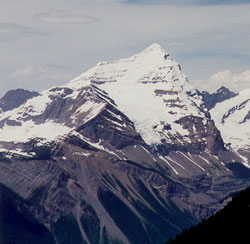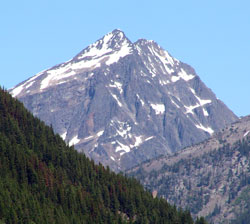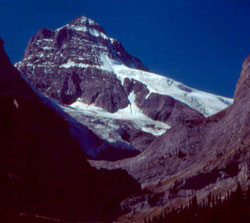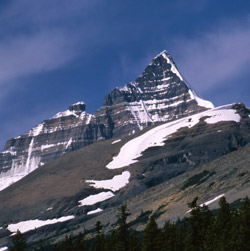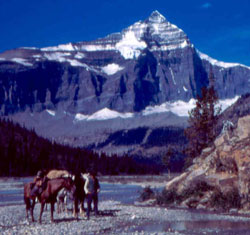
Photo: Whitehorn Mountain from the north end of Kinney Lake (courtesy Dr. John D. Birrell)
Whitehorn Mountain
- 3395 m (11,139ft)
- First Ascent
- Naming History
- Hiking and Trails
Located in the Robson River Valley west of the Valley of a Thousand Falls; head of Swiftcurrent Creek
Province: BC
Park: Mount Robson
Headwater: Fraser
Ascent Party: C. Kain (alone)
Ascent Guide: Conrad Kain
Named by: Arthur Coleman
Named for: This horn-shaped mountain is covered with snow and ice when seen from the north.
Journal Reference: CAJ 6-49; App. 17-33
A pyramid shaped peak, Whitehorn Mountain has been sculpted by four glaciers eroding into it from all directions. Arthur O. Wheeler wrote that, "Mt. Whitehorn is very striking owing to the precipitous rock ramparts, like mighty walls, that stretch out from it to the Grand Fork Valley. It is surrounded by glaciers, but it is not very white and does not convey the impression of a horn." However, this peak to the northwest of Mount Robson was referred to by Arthur Coleman as "The White Horn." When viewed from the northwest, the mountain's summit is draped with ice and snow. In 1911, from a ridge below the summit of Lynx Mountain, Arthur O. Wheeler enjoyed his first view of the Mount Robson area. He later wrote, "As we topped the crest the whole wonderful panorama came into view. At our feet flowed the Robson Glacier. .Across the wide river of ice the great massif of Robson, rising supreme above all other peaks. White against a sky of perfect blue it seemed to belong to a world other than our own. Ethereal, snowy Resplendent Mountain, crowned with immense sculptured cornices; the splendid sharp conical peak of Mount Whitehorn; it was the most stupendous alpine scene I had ever gazed upon, setting the blood coursing though the veins as fast as a torrent, with the pure joy of being alive -and there. Wet and cloudy weather was a problem when Conrad Kain was exploring and climbing in the Mount Robson area during the summer of 1911 with Arthur Wheeler, George Kinney, Byron Harmon and others. According to Kain’s biographer, J. Monroe Thorington, "Overcome with ennui, Conrad went off one afternoon and did not come back at night. The rain poured in torrents. A good blaze was kept up, and rifles were fired at intervals, but no Conrad. He returned next morning, saying that he had made the first ascent of Mount Whitehorn." Conrad’s account of the first ascent of Whitehorn Mountain may be read in CAJ 6-49 or in Kain's autobiography, "Where the Clouds can Go" on page 285. Conrad wrote, "I could stand it no longer, being among beautiful mountains without climbing one." The climb involved a dangerous descent across a glacier at night during a thunder storym. He later described the it by saying, "I had absoutely no pleasure in that climb. The time was too short and the dangers were too great. Two days later I went over the glacier and saw my tracks, and I think there was only one chance in a hundred of anyone coming through safe. I was appalled when I saw the dangerous crevasses. It was one of the craziest and most foolhardy undertakings that I ever made in the mountains, and all my life I shall remember the ascent of Whitehorn. Whitehorn near Lake Louise pales in comparison to this spectacular peak.


